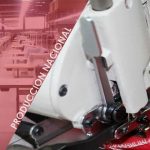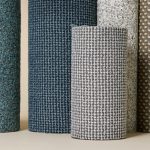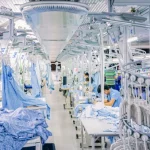By Stephanie Lietz, Development Engineer, Secant Medical LLC
Because material selection intersects the physical, chemical and biological sciences, a multi-disciplinary team of engineers from each of these areas should be involved when evaluating device design and manufacturing options.
Although medical device engineers have been using textile structures for decades, their complexity is increasing as biomaterial and fabric-forming options become more abundant. Some well-known examples include woven and knit polyester tubes that are used to bypass aneurysms in the aorta, and polypropylene warp knit meshes to repair most hernia types. These versatile fabric structures have captured the attention of device engineers and enabled them to achieve unique results unattainable through the use of more rigid structures. As a result, device engineers are starting to realize the importance of defining the form and function of the end device by initially making an informed decision of the biomaterials that affect the component structure design and the development process.
Known Biocompatible Materials
Biomedical textile structures consist of an array of biocompatible materials, including polymers and metals ranging in dimensions, mechanical and physical properties. The exponential combination of these materials and the textile forming processes results in components with highly customizable material characteristics, performance properties and drug-delivery substrates.

PET and Gold braided tube to be used as a component in an electrically active cardiovascular or neurovascular device. Source : Secant Medical LLC

Nitinol circular weft knit mesh can be used for containment (orthopaedics), filtration (cardiovascular) and radial support (delivery system). Source: Secant Medical LLC
All of these options allow device engineers to develop ultra-sophisticated implantable devices across a range of medical therapy areas including orthopedics, cardiology, tissue engineering and neurology. Biomaterial selection is a critical factor in engineering a device to function as required for the remainder of the patient’s life or the intended existence of the device.
There are benefits to working with well-known, established biomaterials such as polyester (polyethylene terephthalate) and polypropylene. Since these materials have been used for decades, there is a wealth of information available to engineers to better understand the mechanical and biological performance indicators to guide them in designing the functionality of a new device. Established materials can also offer device manufacturers a smoother and faster regulatory approval path due to their historical use in implants.
The use of biomaterials that degrade or absorb within the body is increasing in popularity as they are becoming more readily available to device manufacturers.
Common bioabsorbable polymers include but are not limited to PGA (polyglycolides), PLLA (polylacti-des) and their copolymers. These materials are broken down inside the body by different processes of which the most common are hydrolysis and enzymatic degradation.
Bioabsorbable biomaterials have been used in applications associated with nonpermanent or hybrid biologic/synthetic repairs. New textiles constructed from absorbable and bio-active polymers; for example, are ideal in tissue engineering and orthobiologic applications requiring short-term tissue support while the body repairs itself, followed by long-term biologic integration.
In other medical therapy uses, the enhanced mechanical properties, abrasion resistance, chemical inertness, temperature resistance and durability are important design criteria for the functionality of the device. These therapies may require using advanced polymers such as polyetheretherketone (PEEK) and ultra-high molecular weight polyethylene (UHMWPE). As these materials prove their effectiveness, they continue to attract attention among biomedical textile innovators in using these fiber forms to design new textile structures. Textile structures can also incorporate or be made entirely of metals for several added benefits. Nitinol is a common metal utilized in the medical device industry for its super elastic properties.
Utilizing nitinol within a braided structure provides device engineers the benefit of incorporating both the properties of braids and nitinol to allow a shape transformation to occur. The braid can be compacted to fit into a small cannula, and once placed into position, transform to the desired shape. Device engineers can also design in all varieties of stainless steel, cobalt chromium alloys, and titanium based on their mechanical properties and historical use within certain parts of the body. There are also other metals that can be utilized for their radio opacity properties that allow them to be seen under a fluoroscope to provide for easy placement during implantation.
New Material Possibilities
As biomaterial developers introduce new product grades and enhancements, additional material combinations will be available to fit increasingly detailed design parameters. Combinations of resorbable and non-resorbable materials are being used to control device properties over time. Some textile components can now be engineered from materials designed to degrade at varying rates over varying time periods; by synchronizing the modulation of fabric absorption with tissue healing, this multi-phased structural degradation promotes a more biologic repair.
With biomedical textiles, “off the shelf” solutions don’t work very well. Every device application is unique and specialized. Identifying the most appropriate biomaterial and biomaterial supplier is essential for maximizing the performance of the device function. Likewise, the wide variety of therapeutic areas — and the mechanical and physiologic characteristics desired for the finished device — must be used to guide decisions about textile material composition. Because material selection intersects the physical, chemical and biological sciences, a multi-disciplinary team of engineers from each of these areas should be involved when evaluating the options, whether on the side of the device manufacturer or the biomedical textile manufacturer (or a combination of both). Collaboration between the device engineers and their textile engineering counterparts early in the development process is the most effective way of identifying and securing material selection options.
Selection of appropriate biomaterials for use within devices benefits device manufacturers in leveraging these materials for their submission to the FDA with less risk of delays in getting their devices to market. The combination of established and emerging substrates, along with a carefully structured material selection process, offers an effective path toward enhancing the performance of a finished device. For more information, go to http://secantmedical.com/






